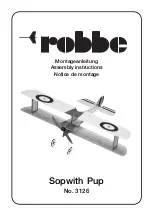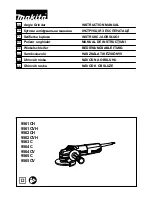
Be sure to read right through these safety notes before you use
the system for the first time.
If you are new to radio-controlled model aircraft, helicopters,
cars or boats, we recommend that you ask an experienced
modeller for help.
Experience with helicopters can be obtained through reading
specialist literature, practising with a flight simulator, or enrol-
ling at a model flying training centre. Electronic aids such as
attitude stabilisers are also available; these can help a begin-
ner to operate such models.
Radio-controlled models are not toys or playthings in the usual
meaning of the term, and they should only be operated by
young people under 14 years if an experienced adult is availa-
ble to supervise them.
Building and operating these models requires technical experti-
se, manual skills, a careful attitude and safety-conscious beha-
viour.
Errors, negligence and omissions in building or operating these
models can result in serious personal injury and damage to pro-
perty.
The manufacturer and vendor of the equipment have no means
of checking that the models are built and operated correctly,
and for this reason we can do no more than expressly bring
these hazards to your attention. We deny all further liability.
Propellers, helicopter rotors and any other rotating object which
is driven by a motor represent a constant hazard and a potenti-
al source of injury.
Avoid touching such parts at all costs. It is sobering to think
that a propeller turning at high speed could cut off your finger.
Whenever an electric motor is connected to a drive battery,
never stand in or close to the primary danger area of the pro-
peller or other rotating parts.
Take care to keep all other objects from making contact with
revolving parts.
Protect your radio control system from dust, dirt and damp.
Do not subject your equipment to excessive heat, cold or vibra-
tion.
Radio control systems should only be used in "normal" condi-
tions, i.e. within the recommended temperature range.
Use recommended battery chargers only, and do not charge
your batteries for longer than the stated periods.
Read and observe the information supplied by the battery manu-
facturer.
Overcharging or incorrect charging methods can cause batte-
ries to explode.
Maintain correct polarity at all times.
Check your system regularly for damage to cases and wiring.
If a unit is damaged in a crash, or gets wet, it should not be
used again even after you have dried it out thoroughly.
The only safe course of action is to replace damaged equip-
ment, or at least have it checked by a robbe Service Centre.
Faults caused by damp or crash-induced shock may not be
obvious to the layman, but after a short period of further use
they may cause terminal failure.
Please use only the components and accessories which we
expressly recommend.
Always use genuine robbe-Futaba connectors and original
robbe-Futaba plug-in crystals.
It is not permissible to make modifications of any kind to the RC
system components.
Routine pre-flight checks
If there are several modellers at your site, ensure that yours is the
only transmitter on "your" frequency before you switch on your
transmitter.
•
Always extend the transmitter aerial fully before operating
your model, and check that it is firmly screwed into its sok-
ket.
•
Ensure that the throttle stick is at stop / idle before you
switch on the receiver.
•
Always switch on the transmitter first, then the receiver.
•
Always switch off the receiver first, then the transmitter.
•
Carry out a range check before the flight or run.
•
Have you selected the correct model memory?
•
Check all the working systems. Ensure that the control sur-
faces respond to the stick commands in the correct "sense"
(right stick = right rudder etc.), and that the travels are as
recommended.
•
Are all the mixer functions and switches set correctly?
•
Are the batteries sufficiently charged?
•
If you are not sure of any point - don’t fly!
Operating the model
•
Never fly above spectators or other pilots.
•
Do not fly in any way which could endanger humans or
animals.
•
Never operate your model close to high-tension overhead
cables or residential areas.
•
Don’t operate your model in the vicinity of canals, locks or
other public shipping routes.
•
You must not operate your model from public roads, motor-
ways, paths, squares etc.
•
Never operate your equipment in stormy weather.
•
If you encounter problems, do not fly or drive again until you
have found the cause and eliminated it. Sudden changes in
flight characteristics are a reliable indicator of a problem.
Don’t "point" the transmitter aerial straight at the model when
flying.
The signal generated by the transmitter is at its weakest in an
imaginary line extending from the aerial. It is always best if the
long side of the aerial points towards the model.
If several radio control systems are in use at the same time on
adjacent channels, the drivers or pilots should always stand
together in a loose group.
Pilots who insist on standing away from the group endanger
their own model as well as those of other pilots.
Insurance
To operate models you will need to extend the cover of your exi-
sting policy of the standard personal third-party insurance poli-
cy or take out a specific policy.
Check your insurance policy and take out a new one if neces-
sary.
Liability exclusion
robbe Modellsport are not in a position to influence the way you
install, operate and maintain the radio control system compo-
nents.
For this reason we are obliged to deny all liability for loss, dama-
ge or costs which are incurred due to the incompetent or incor-
rect use and operation of our products, or which are connected
with such operation in any way.
Unless otherwise prescribed by law, the obligation of the com-
pany to pay compensation is limited to the invoice value of the
robbe products which were immediately and directly involved in
the event which caused the damage.
This does not apply if robbe is found to be subject to unlimited
liability according to binding legal regulation on account of deli-
berate or gross negligence.
Safety notes
10






























